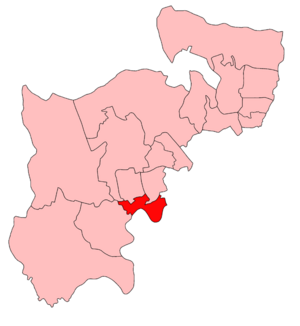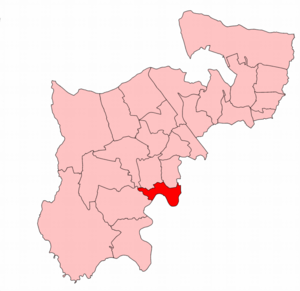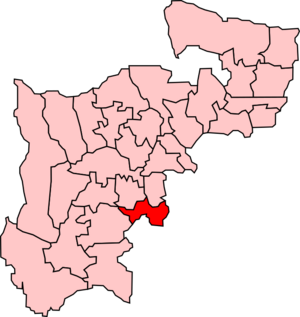Brentford and Chiswick (UK Parliament constituency) facts for kids
Quick facts for kids {{{Name}}}[[{{{Type}}} constituency]] |
|
|---|---|
| [[Image:{{{Map1}}}Constituency.svg|120px|]] [[Image:England{{{Map2}}}.svg|120px|]] |
|
| {{{Name}}} shown within [[{{{Entity}}}]], and {{{Entity}}} shown within England | |
| Created: | {{{Year}}} |
| MP: | {{{MP}}} |
| Party: | {{{Party}}} |
| Type: | House of Commons |
| County: | [[{{{County}}}]] |
| EP constituency: | [[{{{EP}}} (European Parliament constituency)|{{{EP}}}]] |
Brentford and Chiswick was an area in the United Kingdom that elected one person to the House of Commons. This special area is called a constituency. It existed from 1918 until 1974.
The constituency was located around the towns of Brentford and Chiswick. These towns were in Middlesex and later became part of west London in 1965. Most of the time, the people elected from this area were from the Conservative Party. However, in 1945 and 1966, the area elected members from the Labour Party.
Contents
About Brentford and Chiswick
What is a Constituency?
A constituency is like a special voting district. In the UK, each constituency elects one person to be their voice in the UK Parliament. This elected person is called a Member of Parliament, or MP. They represent the people of their area.
Where Was It Located?
The Brentford and Chiswick constituency was in the south-west part of Middlesex. Middlesex was a historic county that is now part of west London. Before 1918, this area was part of a larger constituency called Brentford.
How Did Its Boundaries Change?
When the constituency was first created in 1918, it included the Brentford and Chiswick Urban Districts. These were local government areas. In 1927, these two districts joined together. They formed a single area called the Brentford and Chiswick Urban District. By 1932, this became the Municipal Borough of Brentford and Chiswick.
In 1950, the borders of the constituency stayed the same. But it was officially changed to a "borough constituency." This meant it was seen as a more urban area for voting purposes. In 1965, Brentford and Chiswick became part of the London Borough of Hounslow. This was when it officially became part of Greater London.
Why Did the Population Change?
Over time, the number of voters in Brentford and Chiswick became smaller than in other areas. This happened because the population in the area was actually going down. Many larger houses in Chiswick lost their servants and lodgers. Some crowded housing areas in Brentford were also reduced.
There wasn't much space left for new buildings in this area. Other constituencies to the west and north saw a lot of population growth. However, one area that did grow in Brentford and Chiswick was the number of businesses and offices. Many of these were located near the 'Golden Mile' in Brentford.
What Happened Next?
Because the population changed, the voting areas were reorganized. In February 1974, the Brentford and Chiswick constituency was replaced. A new constituency was created called Brentford and Isleworth. This new area included the eastern part of another abolished constituency, Heston and Isleworth.
Who Represented Brentford and Chiswick?
Members of Parliament Over Time
The table below shows the people who were elected as Members of Parliament (MPs) for Brentford and Chiswick. An MP is a person elected to represent their constituency in the House of Commons.
| Year | Member | Party | |
|---|---|---|---|
| 1918 | Walter Morden | Coalition Conservative | |
| 1922 | Conservative | ||
| 1931 | Harold Mitchell | Conservative | |
| 1945 | Francis Noel-Baker | Labour | |
| 1950 | Percy Lucas | Conservative | |
| 1959 | Dudley Smith | Conservative | |
| 1966 | Michael Barnes | Labour | |
| Feb 1974 | constituency abolished: see Brentford & Isleworth | ||
Images for kids





